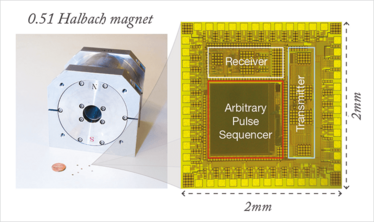NMR Seeds of the Future
Miniature chips aim to deliver portable – or massively parallel – nuclear magnetic resonance (NMR) spectroscopy
NMR spectroscopy is celebrated for its powerful ability to determine molecular structures in atomic detail. Typically, an NMR spectroscopy system consists of two components: a magnet and radio-frequency (RF) spectrometer electronics. In a traditional system, the magnet is a large superconducting magnet while the RF spectrometer electronics exist in a bulky, discrete console. However, a team from Harvard University has now developed a sesame-seed sized alternative. Donhee Ham from the School of Engineering and Applied Sciences, Harvard University, Cambridge, MA, explains the two distinct potential uses for the new chips.

Quick Fire
Could you tell us about the chip design?
The RF chip design was very challenging because its receiver had to be very sensitive, and its transmitter needed to be able to generate an arbitrary pulse sequence to manipulate the proton motions in a variety of complex manners (for various two-dimensional NMR spectroscopy modalities).
What work is needed to ready the chip for a field-ready instrument?
The chip is ready for field deployment!
Where do you see application of parallel arrays?
Pharmaceutical screening and structural biology are at the top of the list, but essentially they can be used in any area that would benefit from high throughput.
In theory, what is the lowest size limit?
The chips are 4 mm2, so they are already very small; we’re not looking to miniaturize these further. For the permanent magnet, it could be made a little smaller, but it must be able to maintain NMR-grade field homogeneity.
Angle 1: Portable NMR spectroscopy (small RF electronic chip + a small permanent magnet)
In the work we presented in the Proceedings of the National Academy of Science (PNAS), we integrated the necessary RF spectrometer electronics into a 2 mm x 2 mm silicon chip (1). We used this chip with a small permanent magnet to perform various NMR spectroscopy experiments.
The point here is that both the magnet and RF electronics are small, thus demonstrating the potential of ‘portable’ NMR spectroscopy. A traditional system with a large superconducting magnet is necessary for probing big and complex molecules like proteins, but in other circumstances – for example, many experiments in biochemistry and organic chemistry, quality control in production lines, and chemical reaction monitoring – you are interested in smaller molecules. For this, the large superconducting magnet isn’t necessary. Small permanent magnets are adequate to resolve small-to-medium size hydrocarbons, drug compounds, and biomolecules, such as metabolites and amino acids. Our portable system could travel to remote sites for online, on-demand applications. It could also be combined with other analytical tools, such as mass spectrometers, chromatography, FTIR, and so on.
Angle 2: High-throughput NMR spectroscopy (many small RF electronic chips in parallel + a large superconducting magnet)
The overall system size reduction described in Angle 1 above is only one part of our vision. We also see potential for a completely different application, where many of the small RF electronic chips could be used in parallel inside a large superconducting magnet bore. By performing hundreds of NMR spectroscopy experiments in parallel, we could tremendously accelerate the analysis of complex molecules. An individual NMR spectroscopy experiment is inherently slow, taking several minutes to hours. Using a hundred small and cheap RF electronics chips in parallel could enable a high-throughput paradigm that could be particularly useful for pharmaceutical screening and structural biology. In theory, one year of testing could be completed in 3.65 days. We have already begun work in this exciting direction.
- D. Ha et al., “Scalable NMR Spectroscopy with Semiconductor Chips”, PNAS 111 (33) 11955-11960 (2014). doi:10.1073/pnas.1402015111

Rich Whitworth completed his studies in medical biochemistry at the University of Leicester, UK, in 1998. To cut a long story short, he escaped to Tokyo to spend five years working for the largest English language publisher in Japan. "Carving out a career in the megalopolis that is Tokyo changed my outlook forever. When seeing life through such a kaleidoscopic lens, it's hard not to get truly caught up in the moment." On returning to the UK, after a few false starts with grey, corporate publishers, Rich was snapped up by Texere Publishing, where he spearheaded the editorial development of The Analytical Scientist. "I feel honored to be part of the close-knit team that forged The Analytical Scientist – we've created a very fresh and forward-thinking publication." Rich is now also Content Director of Texere Publishing, the company behind The Analytical Scientist.

















